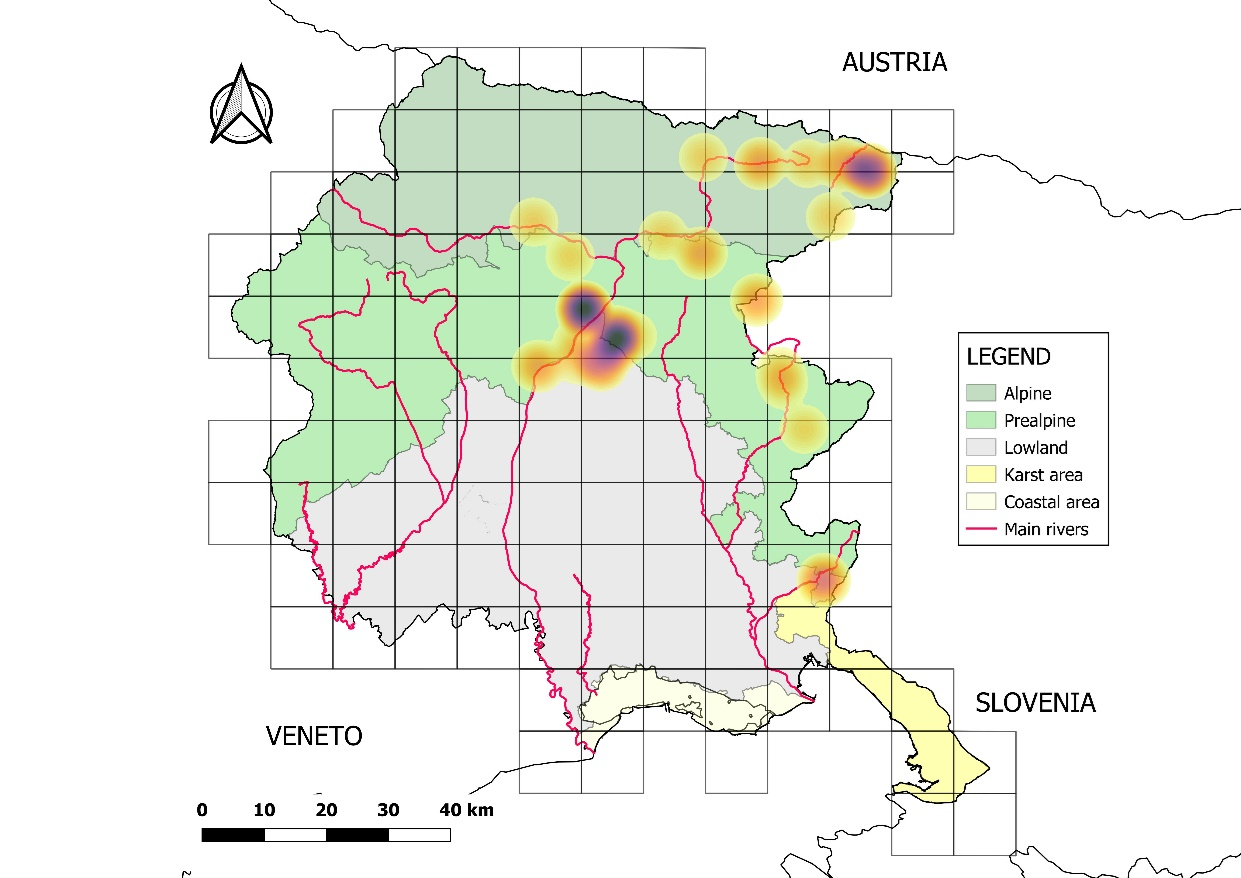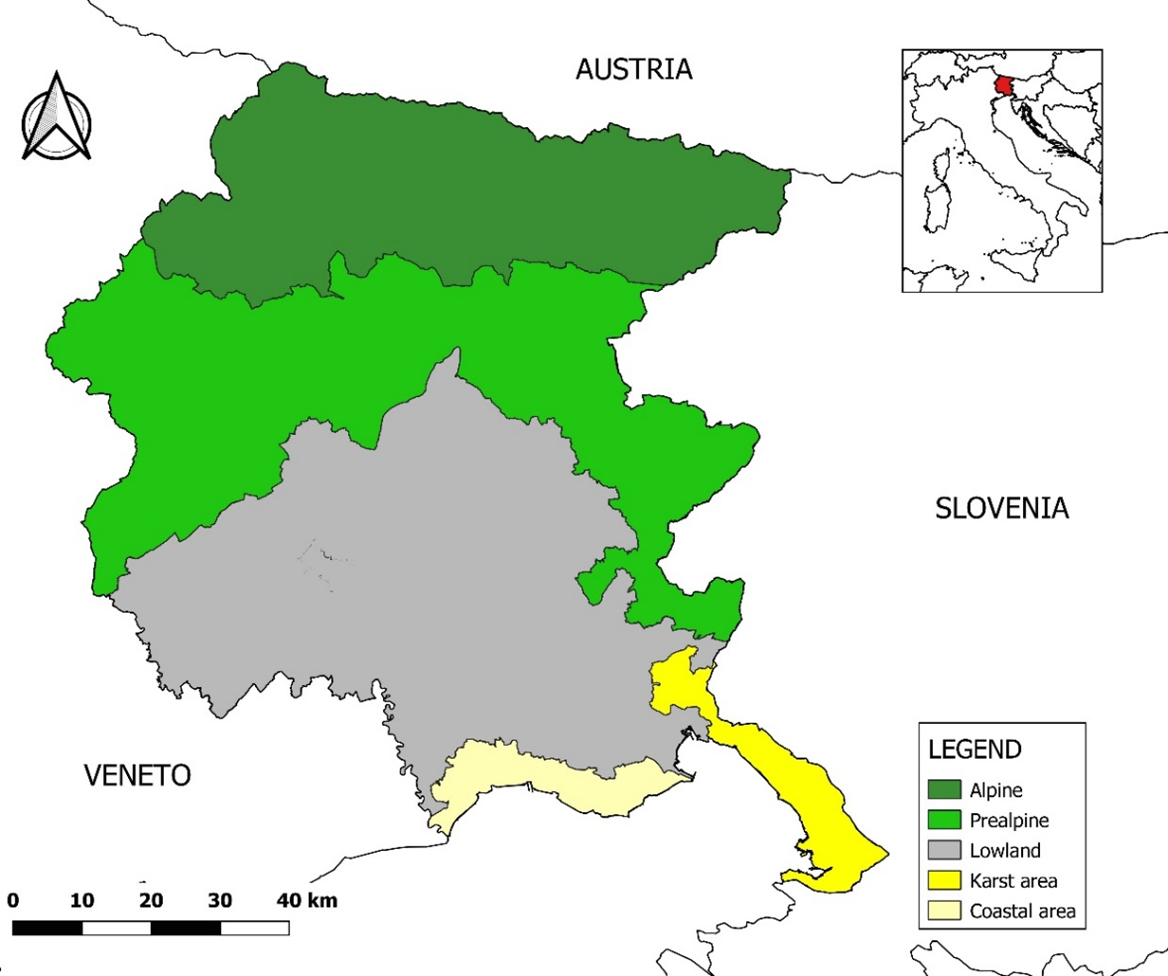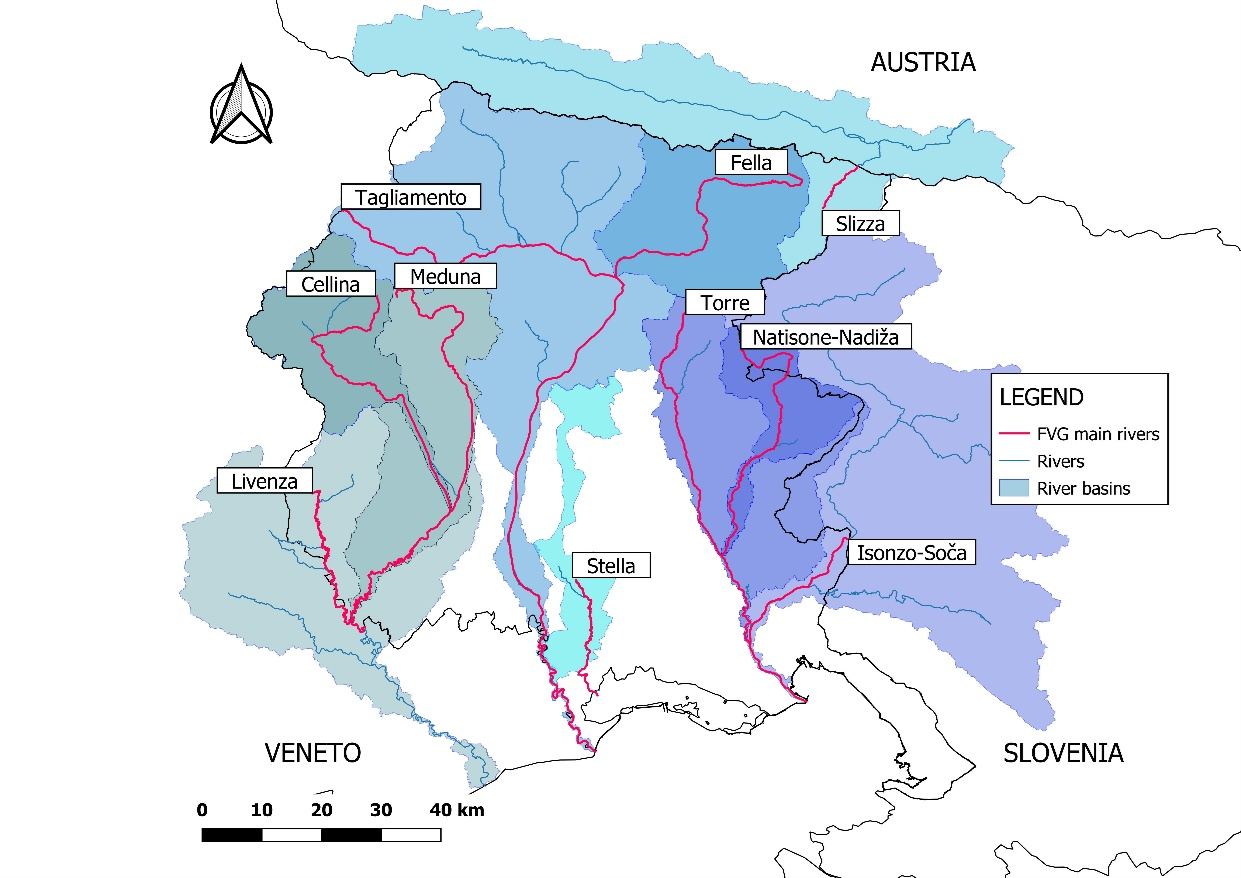IUCN/SSC Otter Specialist Group Bulletin

©IUCN/SCC Otter Specialist Group
Citation: Stokel, G., Franchini, M., Frangini, L., Pizzul, E. and Filacorda, S. (2022). Has the Recolonization of the Po Plain Begun? Updates regarding the Presence of the Otter (Lutra lutra) in North-Eastern Italy. IUCN Otter Spec. Group Bull. 39 (2): 90 - 101
Has the Recolonization of the Po Plain Begun? Updates regarding the Presence of the Otter (Lutra lutra) in North-Eastern Italy
Giacomo Stokel1, Marcello Franchini1, Lorenzo Frangini1*, Elisabetta Pizzul2, and Stefano Filacorda1
1Dipartimento di Scienze agroalimentari, ambientali e animali, Università degli Studi di Udine, via delle Scienze 206, 33100, Udine (UD), Italy
2 Dipartimento di Scienze della Vita, Università degli Studi di Trieste, via L. Giorgieri 10, 34127 Trieste (TS), Italy
*Corresponding Author Email: lorenzo.frangini@uniud.it
(Received 5th November 2021, accepted 31st January 2022)
Abstract: Widespread in Italy in the early 1900s, the Eurasian otter subsequently underwent a dramatic decline that led to its local extinction in many administrative regions, with the exception of a small residual nucleus in southern Italy. For a few years now, the Austrian and Slovenian populations adjacent to north-eastern Italy have been increasing sharply, leading to a recolonization of the area by the species. During 2020, in Friuli Venezia Giulia, surveys of signs of presence were carried out in 48 grid cells (10 x 10 km) to update information on the species’ local distribution. The following monitoring methods were used: monitoring beneath bridges combined with transects along water courses. 17 grid cells tested positive for the presence of the species, and currently, the otter appears widely distributed in Friuli Venezia Giulia along the main waterways of the Eastern Alps and Prealps, and in some areas overlooking the plain of the Tagliamento and the transborder Isonzo-Soča basin, both included in the Po plain. These constitute the first observations of the species for more than 50 years. Compared to previous studies, 13 new grid cells involving the presence of otters were identified, including in lowland areas, suggesting a progressive expansion from the mountain ranges towards the Po-Venetian Plain. This represents, a spur to expand research and implement new studies to improve levels of knowledge about and the consequent protection of the species. Finally, the integration of transects along riverbanks to monitoring beneath bridges, allowed us both to collect numerous observation and to compare our results with previous studies.
Keywords: Eurasian Otter, Smooth-coated Otter, Small-clawed Otter, Northeast India, hunting, illegal wildlife trade
INTRODUCTION
The Eurasian otter (Lutra lutra) represents the most widely distributed species belonging to the subfamily Lutrinae, being distributed from Asia to Europe, with nuclei also present in North Africa (Hung and Law, 2016). In Europe the species has suffered a severe contraction in its historical range as a result of various factors such as the extensive use of pesticides, poaching and habitat loss (Macdonald and Mason, 1994). For this reason, globally, the species is classified as ‘Near Threatened’ by the IUCN (International Union for the Conservation of Nature) (Roos et al., 2015), and ‘Endangered’ at the Italian level (Rondinini et al., 2013). Currently, at a global level, the species is in decline, while in Europe a new expansion is underway (Roos et al., 2015; Yoxon and Yoxon, 2019; Loy and Duplaix, 2020), particularly as a result of European Union regulations which provide for common courses of action for the protection of the species and the safeguarding of the environments it inhabits. In Italy, at the beginning of the 20th century the otter was widespread along the entire of the peninsula (Cavazza, 1911; Cassola, 1986), before it underwent a dramatic decline as a result of several factors stated above. Following these setbacks, at the end of the 20th century, only a small, relict population persisted in southern Italy, with the species being widespread in Basilicata and in parts of Campania, Puglia and Calabria (Cassola, 1986). Meanwhile, in the northern Italy the species went extinct across its historical distribution range, even in the north-eastern area embedding the Friuli Venezia Giulia administrative region (hereafter, FVG) (Cassola, 1986; Prigioni, 2003). However, in 2002-04 a systematic survey realized in southern Italy reported an increase in the otter distribution, compared to the national otter survey conducted in 1984-86 (Marcelli and Fusillo, 2009). Moreover, in northern Italy, two areas were recently naturally recolonized by the species from the bordering Austria: one in the Autonomous Province of Bolzano (Righetti, 2011), and another in FVG (Lapini and Bonesi, 2011; Pavanello et al., 2015). Furthermore, a small population of B-line otters, originated from a reintroduction programme, is established along the Ticino river between Lombardy and Piedmont administrative regions (Prigioni et al., 2009; Tremolada et al., 2020).
In FVG, otters were widespread in the Isonzo basin (on the border with Slovenia), throughout the southern plain, and in the middle course of the Tagliamento river and its tributaries in the central area of the region. In the Carnic and Julian Prealps the species was rarely reported and there are no relevant data for the Alps (Lapini, 1986). The last specimens in FVG were shot in the 1970s (Filacorda, pers. comm.). The first reports after the species’ disappearance referred to single observations of wandering individuals in 1984 and 2008 in which signs of presence were found along the Natisone valleys near the border with Slovenia (Lapini and Bonesi, 2011). However, after years of absence, as a result of the increase of the neighbouring Austrian population (Kranz and Poledník, 2015; Schenekar and Weiss, 2018; Kranz and Poledník, 2020), the otter expanded into some areas of north-eastern Italy along the ecological corridors of the Drava and Gail rivers. In 2011 and 2012 two individuals were run over in the area of the morainic hills and the Prealps (Lapini et al., 2020) and, subsequently, it proved possible to demonstrate a regular presence of the species in the eastern Alps (Pavanello et al., 2015; Lapini et al., 2020). In 2019, the first records were also reported from the western portion of the region (Lapini et al., 2020). Of a more fragmentary nature, however, is the data regarding the dynamics of the expansion of the populations in neighbouring Slovenia (Kryštufek, 2001; Hönigsfeld Adamič, 2010). Although the data available varies in quality and consistency, the expansion from the eastern sector to the FVG appears to be less strong. This said, the ecological corridor represented by the Isonzo-Soča river and its tributaries (the river Natisone-Nadiža in primis, but also the Vipacco-Vipava and Uccea-Ucja rivers) is extensive and potentially represent an optimal link between Slovenia and Italy (Pavanello et al., 2015). Based on the information collected, the purpose of this study is therefore to deepen and broaden knowledge regarding the distribution of the otter in FVG, a key area for the species’ expansion and recolonization of north-eastern Italy, through the integration of transects along riverbanks to the monitoring beneath bridges.
MATERIALS AND METHODS
Study area
The study was conducted within the Friuli Venezia Giulia administrative region (FVG) in north-eastern Italy, bordering Austria and Slovenia. Morphologically it is a heterogeneous zone, divided into five ecoregions (Fig. 1, Tab. 1) (Poldini et al., 2006): (i) Alpine and (ii) Prealpine, with the Carnic Alps and Prealps to the west and the Julian Alps and Prealps to the east, (iii) the plain, which also includes the morainic hills to the north, divided into a high plain to the north and a low plain to the south, (iv) the Karst, and (v) coastal areas. Specifically, the Veneto-Friulian plain is part of the Po plain, representing its north-easter offshoot (Stoch, 2009).
From the hydrographic perspective, the two main rivers are the Tagliamento, the source of which lies in the Carnic Alps, and the Isonzo-Soča, which rises in the Julian Alps in Slovenia. Both cross the FVG and serve as important corridors to north-eastern Europe. Other important watercourses (Fig. 2) include the Livenza and the Stella, spring-fed rivers and historically inhabited by otters (Lapini, 1986), the river Fella which is in connection with the transborder Slizza-Gailitz torrent, which then crosses into Austria and enters the river Gail, the rivers Torre and the Natisone, which rise in the Julian Prealps, and the Meduna and the Cellina, two streams that originate in the Carnic Prealps.
Survey design
The study area was divided into 113 10 x 10 km UTM grid cells, as required by the European protocol IUCN / SSC Otter Specialist Group (Reuther et al., 2000) and in line with the provisions of the National Action Plan for the Conservation of the otter (Panzacchi et al., 2011). The survey was conducted within grid cells in which recent (less than 20 years) observations were obtained, in nearby cells, and where the species was historically distributed. Grid cells to be considered in the sampling design were chosen based on bibliographic information (Lapini et al., 2020) reporting the presence of the species, and data stored in archives of the University of Udine (Filacorda, unpub. data), referring to both opportunistic observations and collected biological samples (mainly spraints and footprints). Moreover, suitable areas within each grid cell, able to favour the expansion of the species but not close to areas where the presence was recently ascertained, were selected based on the parameters of the land use and altitude (Loy et al., 2009; Ottaviani et al., 2009). The presence of otters was reported searching for signs of presence (spraints and jellies mainly) under 6 bridges in each cell, on average, as otters frequently mark under or near them, and footprints can often be found (Chanin, 2003), similarly to the previous systematic otter survey in FVG (Pavanello et al., 2015). Furthermore, in 20 grid cells we realized four transects of 100 or 500 m for each side of the riverbanks, and both north and southward starting from the monitored bridge. This was done to collect additional data that would provide further insights on both the presence of otters and the density of signs of presence in the study area.
The choice of bridges was made on the basis of three criteria: (i) the distance among them, (ii) the representativeness of the hydrographic bodies involved (e.g., streams, water channels, main rivers), and (iii) their accessibility. Following the information reported in the protocols and guidelines (Reuther et al., 2000; Panzacchi et al., 2011), an attempt was made to maintain a distance of about 5 km among the bridges in order to avoid potential pseudo-replication errors. However, given the heterogeneous morphology of the area, especially in the mountainous part, this was not always possible. The presence of different hydrographic bodies within each single grid cell was also considered, to try to obtain a good representativeness of them from the transects. Finally, the accessibility of the riverbed was a very influential factor, and thus those bridges that guaranteed easy access were chosen (Reuther et al., 2000). In summary, the bridges were considered as suitable if sufficiently distant from one another, if they were representative of the different environments for each grid cell and based on their accessibility.
Each grid cell was monitored twice, approximately one month apart, in the period between September and December 2020, for a total of 362 bridges monitored and 150 km performed. In order to visualize the distribution and intensity of the signs of presence (spraints, jellies, footprints) collected during the first monitoring session, their density was calculated using the quartic kernel method (Pennec et al., 2020), an interpolation algorithm, through the heatmap function of QGIS (Quantum Geographic Information System, v. 3.1.6). For a clearer representation on the map, a buffer of 5 km around each positive site was chosen, which is useful for discriminating the areas with greater density compared to the size of the study area.
RESULTS
Otter presence was detected in n=17 grid cells out of 48, corresponding to 35% of those monitored. Most of the positive grid cells fell within the area of the Julian Alps and Prealps, with signs of presence in the Carnic Alps and Prealps as well, together with three positive grid cells in the lowland areas (Fig. 3). From the survey of bridges, 35 signs of presence (31 spraints and 4 footprints,) were recorded during the first monitoring session (x=2.92 ± 2.94, mean of signs per positive grid cell), while in the second session the number decreased to 18 (17 spraints and 1 footprint; x=4.50 ± 4.04). By means of transects survey, 11 signs of presence (2 spraints, 3 footprints, 2 jellies, 3 slides, 1 rest of predation) were recorded during the first campaign (x=1.57 ± 1.13), and 25 (22 spraints, 1 footprint, 1 slide) during the second one (x=2.78 ± 2.28). Finally, one carcass of a road killed individual was opportunistically discovered during the monitoring period. 52% of the signs of presence were detected in two grid cells: one (n = 25, number of observations) along the border with Austria and Slovenia in the Julian Alps, and the other (n=22) between the Prealps and lowland, as shown in the density map (Fig. 4). The remaining signs of presence were found, in descending order of abundance: (i) in the Julian Alps and the Prealps, (ii) in the Isonzo plain, near the border with Slovenia, (iii) in the Prealpine area of the Natisone basin, (iv) in the Carnic Alps and Prealps (Fig. 4). Considering the river basins, the 86% (n=77) of positive signs fall in the Tagliamento basin (which also included the Slizza-Gailitz rivers), whereas the remaining signs were detected in the Isonzo-Soča basin. In the Tagliamento basin, the number of observations reaches its maximum in the Julian Alps, and then decreases from the mountains towards the lowlands along the course of the Fella river, increasing once again reaching the Prealps and the area of the plain including the morainic hills (Fig. 4). In the Isonzo-Soča basin, on the other hand, the remaining 14% (n=3) of the observations were recorded, mainly in the Prealpine and in the plain grid cells.


DISCUSSION
The results of the large-scale survey conducted in FVG indicate that the otter is currently mainly distributed within the Alpine and Prealpine areas, but the first occurrences have also been detected in lowland areas, including the areas of the morainic hills. Therefore, it can be said that the species has begun its recolonization of the Po Plain starting from its north-easternmost area, returning to occupy territories where it had been missing for fifty years but that still appear very suitable for the species. Compared to the previous systematic survey conducted within FVG (Pavanello et al., 2015), there has been a significant expansion of the species, since it has been detected in an additional 13 grid cells. These differences in the results achieved most likely derive by the increase in terms of sampling effort in the area. Confirming this, 58% of the observations were obtained searching beneath bridges, and the 42% with the transects method. Moreover, the number of spraints found during a visit may vary as a function of a number of factors, not only in accordance with the use of the site by the otter (Mason and Macdonald, 2009). Therefore, it is very important to combine the pinpointing of bridges, useful for the low sampling effort required, with the use of transects, as this allows an increase in the probability of detecting the species, and thus obtaining a better representation of the local distribution (Romanowski et al., 1996; Reuther and Roy, 2001; Elmeros and Bussenius, 2002).
The area with the highest density of signs of presence turned out to be the north-eastern area, in the Julian Alps, likely related to the flow of individuals from the currently expanding and neighbouring Austrian population (Kranz and Poledník, 2015; Schenekar and Weiss, 2018; Kranz and Poledník, 2020), and where the first reproductive nucleus within north-eastern Italy was found (Pavanello et al., 2015). This is likely the source population for the nucleus that first colonized the Julian Alps, which then expanded along the Fella river in the Julian Prealps and, via the Tagliamento, towards the Carnic Alps and Prealps, as witnessed by the road-killed young male discovered during the survey period.
Within the Carnic Alps, recent studies (Lapini et al., 2020; Filacorda, unpub. data) have highlighted the presence of the species. Furthermore, in 2019 otter markings were also detected in the neighbouring Veneto administrative region, along the course of the Digon torrent, upstream of Sega Digon (Filacorda, unpub. data). However, in the present study the same area was extensively monitored in both survey campaigns, but the presence of the species was not detected in the course of 2020. It was hypothesized that the aforementioned negative result may be linked to the low detectability of the species in an area of recent re-expansion (Marcelli and Fusillo, 2018), along with human disturbance during the monitoring period (logging works and the restoration of the river banks following the 2019 “Vaia” natural disaster, a powerful autumn storm that destroyed millions of trees) (Udali et al., 2021). In the southernmost area of the Alps and in the Carnic Prealps, signs of the species were found in the area near the confluence between Tagliamento and Fella. This represents a new point of area of occurrence, and the discovery of the road-killed young male confirms that an expansion is taking place in the area, as are usually young males that undertake long journeys to colonize new areas (Arrendal, 2007).
In the eastern Prealpine area (the Julian Prealps), signs of otter presence were found in an already known area (Lapini et al., 2020), referring to the transborder Uccea-Učja torrent, right tributary of the Isonzo-Soča river flowing across Slovenia. The second positive area in the Prealps corresponds to the middle course of the Natisone river and some of its tributaries. In this area, the first signs of otters in FVG were recorded and attributed to wandering individuals (Lapini and Bonesi, 2011). In the present study, signs of presence were extensively detected during both campaigns, suggesting the existence of a stable population in the Natisone basin. However, during the monitoring period the banks of the Natisone and its tributaries were subjected to intensive working activities that caused severe disturbance to the ecosystem. Therefore, it was necessary to move a transect in which signs of presence were detected during the first monitoring session.
In both areas, a Slovenian origin of the individuals can be hypothesized, with particular reference to the upper reaches of the Isonzo-Soča river, including the left tributary Idria (Kryštufek, 2001; Hönigsfeld Adamič, 2010), and considering the Uccea, Natisone and Vipacco rivers as suitable ecological pathways, as hypothesized in Pavanello et al. (2015). Currently the Isonzo-Soča and its tributaries, including the Vipacco-Vipava, probably host a stable population of otters (https://www.projektvipava.si/ ), likely up to the mouth of the river itself (Filacorda, pers. comm.).
Of particular interest is the recent expansion of the species in the hills and lowlands where the species has been making a steady return after 50 years. Specifically, the otter has been found along various watercourses in the amphitheatre of the morainic hills and in the northernmost part of the Po Plain. In fact, in 2011 and 2012 two wandering otters were road-killed in the morainic hills and in the Prealpine area, respectively (Lapini et al., 2020). However, subsequent research did not confirm the presence of the species. During this study, various markings and signs of presence suggest that otters have definitely returned to their former range. Individuals in the morainic hills are largely linked to the Tagliamento river and its tributaries and probably dispersed from the Alpine region (Pavanello et al., 2015; Lapini et al., 2020), whereas otters in the plain probably come from the upper course of the Vipacco-Vipava river.
CONCLUSIONS
Our outcomes represent the first evidence of a permanent return of the otter in the lowland of Friuli Venezia Giulia. The current distribution of the otter in FVG confirms the positive trend that the species is enjoying in Europe, with the rapidly expanding Austrian population along the Fella-Tagliamento, as well as the growing Slovenian population in the Isonzo-Soča basin. Both components show the return of the species to hilly and plains habitats, from which it had been missing since the 1970s. The distribution, even compared to recent studies, encourages further investigations and the implementation of further cross-sectional studies. Furthermore, it is also important to consider human disturbance, the primary cause of loss of suitable habitats for the species, particularly in lowland areas. This makes it necessary to study the population, together with the preparation of action strategies at an interregional level to protect the species, with a particular focus on habitat destruction and the impact of the road network. Finally, the experimental design used in this work, that is to say the integration of transects along riverbanks to monitoring beneath bridges, allowed us both to collect numerous observation and to compare our results with previous studies.
Acknowledgements: Part of the activities of this research were funded by the Nat2care Interreg V-A Italy – Slovenia 2014-2020 project. We would like to thank Mr. Paul Tout for the useful comments which improved the quality of the manuscript, and for revising the English level.
REFERENCES
Arrendal, J. (2007). Conservation Genetics of the Eurasian Otter in Sweden. Acta Universitatis Upsaliensis. Digital Comprehensive Summaries of Uppsala Dissertations from the Faculty of Science and Technology 278. 60 pp. Uppsala. ISBN 978-91-554-6816-3. http://www.carnivoreconservation.org/files/thesis/arrendal_2007_phd.pdf
Cassola, F. (1986). La lontra in Italia. Censimento, distribuzione e problemi di conservazione di una specie minacciata. WWF Italia, Serie Atti e Studi 5. [in Italian]
Cavazza, F. (1911). Dei Mustelidi Italiani. Ann. Mus. Civ. St. Nat. Genova 5: 170-204. [in Italian]
Chanin, P. (2003). Monitoring the Otter Lutra lutra. Conserving Natura 2000 Rivers Monitoring Series No. 10, English Nature, Peterborough.
Elmeros, M., Bussenius, N. (2002). Influence of Selection of Bank Side on the Standard Method for Otter Surveys. IUCN Otter Specialist Group Bulletin 19: 67-74. https://www.iucnosgbull.org/Volume19/Elmerson_Bussenius_2002.html
Hönigsfeld Adamič, M. (2010). Vidra (Lutra lutra). Ljubljana, Lutra, Inštitut za ohranjanje naravne dedišcine. [in Slovenian]
Hung, N., Law, C.J. (2016). Lutra lutra (Carnivora: Mustelidae). Mammalian Species, 48: 109-122.
Kranz, A., Poledník, L. (2015). Fischotter in Kärnten: Verbreitung und Bestand 2014. Endbericht im Auftrag des Amtes der Kärntner Landesregierung. [in German]
Kranz, A., Poledník, L. (2020). Recolonization of the Austrian Alps by otters: conflicts and management. Journal of Mountain Ecology, 13: 31-40.
Kryštufek, B. (2001). Raziskava razširjenosti evropsko pomembnih vrst v Sloveniji. Prirodoslovni muzej Slovenije, Ljubljana. Neobjavljeno porocilo za Ministrstvo za okolje in prostor: 655-657. [in Slovenian]
Lapini, L. (1986). La lontra in Friuli Venezia Giulia. In: La lontra in Italia - Censimento, distribuzione e problemi di conservazione di una specie minacciata. WWF Italia, Serie Atti e Studi 5. [in Italian]
Lapini, L., Bonesi, L. (2011). Evidence of the natural recovery of the Eurasian otter in NE Italy. 29th European Mustelid Colloquium, 3–4 Dec 2011, Southampton, UK.
Lapini, L., Pontarini, R., Molinari, P., Cantarutti, G., Dorigo, L., Pecorella, S., Cesco, N., Commessatti, G., Comuzzo, C., Da Pieve, J., De Belli, E., Dreon, A.L., Giacomuzzi, D., Luca, M., Mareschi, A., Picco, G., Rossi, A. (2020). The return of the Eurasian otter in north-eastern Italy. New challenges for biological conservation from Friuli Venenzia-Giulia Region. Journal of Mountain Ecology, 13: 41-50.
Loy, A., Carranza, M.L., Cianfrani, C., D'Alessandro, E., Bonesi, L., Di Marzio, P., Minotti, M., Regiani, G. (2009). Otter Lutra lutra population expansion: assessing habitat suitability and connectivity in southern Italy. Folia Zoologica 58: 309.
Loy, A., Duplaix, N. (2020). Decline and recovery of the otter in Europe. Lessons learned and future challenges. Journal of Mountain Ecology, 13: 1-8.
Macdonald, S.M., Mason, C.F. (1994). Status and conservation needs of the otter (Lutra lutra) in the Western Palearctic. Strasbourg: Council of Europe.
Marcelli M., Fusillo R. (2009). Assessing range re-expansion and recolonization of human-impacted landscapes by threatened species: a case study of the otter (Lutra lutra) in Italy. Biodiversity and Conservation 18: 2941–2959
Marcelli, M., Fusillo, R. (2018). Occupancy modelling and power analysis to detect trends in threatened species. An example with the otter (Lutra lutra) in Italy. Hystrix Italian Journal of Mammology 29 Suppl. 2018: 40.
Mason, C.F., Macdonald, S.M. (2009). Otters: Ecology and Conservation. Cambridge University Press, 248 pp.
Ottaviani, D., Panzacchi, M., Jona Lasinio, G., Genovesi, P., Boitani, L. (2009). Modelling semi-aquatic vertebrates’ distribution at the drainage basin scale: The case of the otter Lutra lutra in Italy. Ecological Modelling 220 (2): 111-121.
Panzacchi, M., Genovesi, P., Loy, A. (2011). Piano d’Azione Nazionale per la Conservazione della Lontra (Lutra lutra). Quad. Cons. Natura, 35, Min. Ambiente - ISPRA. [in Italian]
Pavanello, M., Lapini, L., Kranz, A., Iordan, F. (2015). Rediscovering the Eurasion Otter (Lutra lutra) in Friuli Venezia Giulia and notes of its possible expansion in northern Italy. IUCN Otter Specialist Group Bulletin 32: 12-20. https://www.iucnosgbull.org/Volume32/Pavanello_et_al_2015.html
Pennec, F., Gérard, C., Meterreau, L., Monghiemo, C., Bokika Ngawolo, J.C., Laurent, R., Narat, V. (2020). Spatiotemporal variation in Bonobo (Pan paniscus) habitat use in a forest–savanna mosaic. International Journal of Primatology 41: 775-799.
Poldini, L., Oriolo. G., Vidali, M., Tomasella, M., Stoch, F., Orel, G. (2006). Manuale degli habitat del Friuli Venezia Giulia. Strumento a supporto della valutazione d’impatto ambientale (VIA), ambientale strategica (VAS) e d’incidenza ecologica (VIEc). Regione Autonoma Friuli Venezia Giulia – Direz. Centrale ambiente e lavori pubblici – Servizio Valutazione Impatto Ambientale, Univ. Studi Trieste – Dipart. Biologia, 1078 pp. [in Italian]
Prigioni, C. (2003). In: Boitani, L., Lovari, S., Taglianti, A.V. (2003). Fauna d'Italia. Mammalia III. Carnivora - Artiodactyla. Calderini (Ed). [in Italian]
Prigioni, C., Smiroldo, G., Remonti, L., Balestrieri, A. (2009). Distribution and diet of reintroduced otters (Lutra lutra) on the river Ticino (NW Italy). Hystrix Italian Journal of Mammology 20: 45-53.
Reuther, C., Dolch, D., Green, R., Jahrl, J., Jefferies, D., Krekemeyer, A., Kucerova, M., Bo Madsen, A., Romanowsky, J., Roche, K., Ruiz-Olmo, J., Teubner, J., Trinidade, A. (2000). Surveying and monitoring distribution and population trends of the Eurasian Otter (Lutra lutra): guidelines and evaluation of the standard method for surveys as recommended by the European Section of the IUCN/SSC Otter Specialist Group. Habitat 12: 1-148.
Reuther, C., Roy, A. (2001). Some results of the 1991 and 1999 otter (Lutra lutra) surveys in the River Ise catchment, Lower-Saxony, Germany. IUCN Otter Specialist Group Bulletin 18: 28-40. https://www.iucnosgbull.org/Volume18/Reuther_Roy_2001.html
Righetti, D. (2011). Return of the otter in South Tyrol (NE Italy). In: Prigioni, C., Loy, A., Balestrieri, A., Remonti, L. (eds) Abstracts 11th International Otter Colloquium. Hystrix Italian Journal of Mammology Supp: 122.
Romanowski, J., Brzezinski, M. and Cygan, J. P. (1996). Notes on the technique of the otter field survey. Acta Theriologica 41: 199-204.
Rondinini, C., Battistoni, A., Peronace, V., Teofili, C. (2013). Lista Rossa IUCN dei Vertebrati Italiani. Comitato Italiano IUCN e Ministero dell’Ambiente e della Tutela del Territorio e del Mare. [in Italian]
Roos, A., Loy, A., de Silva, P., Hajkova, P., Zemanová, B. (2015). Lutra lutra. The IUCN Red List of Threatened Species 2015: e.T12419A21935287. https://dx.doi.org/10.2305/IUCN.UK.2015-2.RLTS.T12419A21935287.en.
Schenekar, T., Weiss, S. (2018). Genetische Untersuchungen der Populationsgröße des Eurasischen Fischotters in den Kärntner Fließgewässern. Final Report on behalf of Amts der Kärntner Landesregierung, 53 pp. [in German]
Stoch, F. (2009). Gli habitat italiani – Espressione della biodiversità. Museo Friulano di Storia Naturale, Udine, Italy. [in Italian]
Tremolada, P., Smiroldo, G., Verduci, F., Gatti, E., Boggioni, P., Gianfranceschi, L., Prigioni, C., Capelli, E., Balestrieri, A. (2020). The otter population of the River Ticino (N Italy) 20 years after its reintroduction. Journal of Mountain Ecology, 13: 51-62.
Udali, A., Andrighetto, N., Grigolato, S., Gatto, P. (2021). Economic Impacts of Forest Storms - Taking Stock of After-Vaia Situation of Local Roundwood Markets in Northeastern Italy. Forests 12 (414).
Vipava (2021). https://www.projektvipava.si/ (last accessed 1/10/2021)
Yoxon, P. and Yoxon, B. (2019). Eurasian otter (Lutra lutra): A review of the current world status. OTTER, Journal of the International Otter Survival Fund, 53-73.
Résumé: La recolonisation de la plaine du Pô a-t-elle commencé ? Mises à Jour Concernant la Présence de la Loutre Eurasienne (Lutra lutra) dans le nord-est de l’Italie
Répandue en Italie au début des années 1900, la loutre eurasienne a ensuite subi un déclin dramatique qui a conduit à son extinction locale dans de nombreuses régions administratives, à l’exception d’un petit noyau résiduel dans le sud de l’Italie. Depuis quelques années, les populations autrichiennes et slovènes voisines du nord-est de l’Italie sont en forte augmentation, entraînant une recolonisation de la zone par l’espèce. En 2020, dans le Frioul-Vénétie Julienne, des relevés d’indices de présence ont été effectués dans 48 carrés (10 x 10 km) pour mettre à jour les informations sur la répartition locale de l’espèce. Les méthodes de surveillance suivantes ont été utilisées : surveillance sous les ponts combinée à des transects le long des cours d’eau. 17 carrés de la grille ont été positifs pour la présence de l’espèce, et actuellement, la loutre semble largement distribuée dans le Frioul-Vénétie Julienne le long des principales voies navigables des Alpes orientales et des Préalpes, et dans certaines zones surplombant la plaine du Tagliamento et l’Isonzo- Bassin de la Soca, toutes deux incluses dans la plaine du Pô. Celles-ci constituent les premières observations de l’espèce depuis plus de 50 ans. Par rapport aux études précédentes, 13 nouveaux carrés impliquant la présence de loutres ont été identifiés, y compris dans les zones de plaine, suggérant une expansion progressive à partir des chaînes de montagnes vers la plaine du Po-vénitienne. Ces résultats sont un encouragement à étendre la recherche et à mettre en œuvre de nouvelles études pour améliorer les niveaux de connaissance et la protection conséquente de l’espèce. Enfin, l’intégration des transects le long des berges au suivi sous les ponts, nous a permis à la fois de recueillir de nombreuses observations et de comparer nos résultats avec des études antérieures.
Revenez au dessus
Resumen: ¿Ha Comenzado la Recolonización de la Planicie del Po? Actualización Acerca de la Presencia de la Nutria (Lutra lutra) en el Noreste de Italia
Ampliamente distribuida en Italia a comienzos de los 1900s, la nutria Eurasiática subsiguientemente sufrió una declinación dramática que condujo a su extinción local en muchas regiones administrativas, con la excepción de un pequeño núcleo residual en el sur de Italia. Desde hace varios años, las poblaciones de Austria y Eslovenia adyacentes al noreste de Italia han estado aumentando muy significativamente, lo que condujo a una recolonización del área por parte de la especie. Durante 2020, en Friuli Venezia Giulia, se condujeron relevamientos de signos de presencia, en 48 celdas de 10 x 10 km para actualizar la información sobre la distribución local de la especie. Fueron usados los siguientes métodos de monitoreo: monitoreo debajo de puentes, combinado con transectas a lo largo de cursos de agua. 17 celdas de la grilla resultaron positivas para la presencia de la especie, y actualmente la nutria parece estar ampliamente distribuida en Friuli Venezia Giulia, a lo largo de los principales cursos de agua de los Alpes y Prealpes Orientales, y en algunas áreas que dan a la planicie de las cuencas de Tagliamento y la transfronteriza de Isonzo- Soča, ambas incluidas en la planicie del Po. Éstas constituyen las primeras observaciones de la especie después de más de 50 años. En comparación con estudios previos, fueron identificadas 13 nuevas celdas con presencia de nutrias, incluyendo áreas bajas, lo que sugiere una progresiva expansión a partir de los cordones montañosos hacia la Planicie Po-Veneciana. Esto representa un estímulo para expandir la investigación e implementar nuevos estudios para mejorar los niveles de conocimiento acerca de la especie -y su consecuente protección. Finalmente, la integración entre las transectas a lo largo de barrancas de ríos y el monitoreo debajo de puentes, nos permitió tanto colectar numerosas observaciones como comparar nuestros resultados con estudios previos.
Vuelva a la tapa






